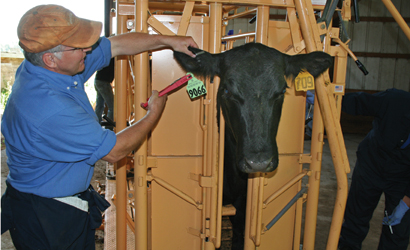RFID Speeds Up TB Testing

 In just a little more than an hour—less than 15 seconds a head—300 yearlings can be run through an alley and tested for bovine tuberculosis (TB) by Thor Didrikson and veterinarians from the Minnesota Board of Animal Health.
In just a little more than an hour—less than 15 seconds a head—300 yearlings can be run through an alley and tested for bovine tuberculosis (TB) by Thor Didrikson and veterinarians from the Minnesota Board of Animal Health.
The key to such speed: RFID electronic ear tags that are instantly read with nearly complete accuracy by a hand-held wand. "It’s a lot less stressful on calves, because they spend less time in the chute," says Didrikson, who, with his dad, runs 250 to 300 cow–calf pairs.
The farm is located near Badger in extreme northwest Minnesota, just 15 miles south of the Canadian border. The operation’s 2,600 acres lie within Minnesota’s TB modified accredited (MA) zone and, as such, its cattle must be tested annually.
Bovine TB was diagnosed in northwest Minnesota in 2005. The MA zone was established to help expedite the eradication efforts in the area.
Without the RFID tags, the testing crew would have to visually read tags and manually check them off their list. "Without RFID, we’d be yelling out tag numbers. Using RFID tags decreases the noise and stress levels on the calves. It’s fast," Didrikson says.
Of the 272 beef and dairy herds within the MA zone, all but a few have agreed to use the RFID technology, says Beth Thompson, senior veterinarian for the Minnesota Board of Animal Health (MBAH). Each calendar year, MBAH veterinarians test more than 15,000 cattle for TB.
"We use the RFID system mainly for tracking cattle movement and for our routine tests," Thompson says. Herds in the zone must be tested annually and, if sold for breeding, they must be tested within 60 days of movement. Area sale barns are also installing flat-panel readers to more easily track cattle.
The RFID technology offers producers and veterinarians speed and accuracy, says Ray Scheierl, MBAH information technology manager.
"We can now do five herds a day rather than the three we were able to get through with visual ID," he says. "And the accuracy is so much better. Metal tags are hard to read, and with beef cattle that aren’t used to being handled, it’s especially difficult."
The tags are provided free through the Minnesota TB testing program. Concerns that government
agencies can read individual cattle tags at long distances are simply not true; the wands or flat-panel receivers must be within 12" to 18" to pick up the signal from the full-duplex, low-frequency tags.
On record. In most operations the tags are attached when the yearlings receive their first TB tests. Minnesota uses the caudal-fold test, a two-step process.
First, veterinarians inject a tuberculin within the layers of skin of the caudal tail fold. Cattle are run through a chute for the procedure, and the RFID tags are applied at the same time.
The test is read by the veterinarian 72 hours later, which means the cattle have to be run through the chute a second time. The RFID tags make connecting the animal ID and test result easier.
For quick identification, the last four digits of the RFID number are visually printed on a traditional ear tag. Many producers in the program use that visual identification number to track cattle for their own herd management activities.
To date, Didrikson has relied on the visible four-digit tag to track his cattle for TB and other herd management protocols. When he can afford it, he says that he would like to purchase a wand and hand-held PDA to fully computerize his record keeping.
The only downside to the system that Didrikson sees is the possibility that heifer buyers will bid less money for cattle that carry RFID tags and come out of the TB management zone. However, MBAH has not been able to document any price discrimination of this kind. BT
To contact Jim Dickrell, e-mail jdickrell@farmjournal.com.







